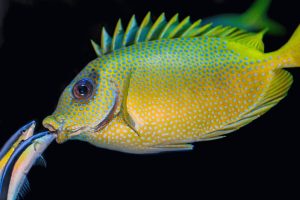Cleaner fish more self-aware than thought

A study published in February calls into question the widely held belief that fish are stupid, by showing that they can recognise their own reflection.


A study published in February calls into question the widely held belief that fish are stupid, by showing that they can recognise their own reflection.
Human activities are altering landscapes, dividing habitats and changing ecosystems. We rarely hear of any good coming from this, mostly because there isn’t. However, recent research has revealed an interesting evolutionary consequence of road construction for a small fish in the Bahamas. Over just 50 years of evolution, females in fragmented populations have exercised their preference to produce males that are better equipped to please them and more considerate of their feelings.
Humans are constantly modifying our landscape to make it more connected. We build roads, tunnels and bridges, we design boats and planes, all in an attempt to maximise our ability to move around. At the same time, these human structures are dividing ecological landscapes – our roads create barriers that keep many species from crossing and can have a significant impact on ecosystems. This is known as habitat fragmentation and it is one of the biggest concerns for biodiversity. Habitat fragmentation can split groups and isolate small, vulnerable or unviable populations. This can be a huge problem, reducing genetic diversity and leading to local or even global species extinction.
What can this squiggling, toothed eel-like creature possible tell us about our own brains? Well, the lamprey, although ugly, occupies a pivotal place in the evolutionary tree. Research on captive lampreys can tell us about the earliest evolution of the vertebrate brain and yield insights that may help to cure and treat neurological disease. A new study published in Nature last month suggests that the human pattern of development in an important region of our brains may have evolved much earlier than we thought, in a creature that looks much like a modern-day lamprey. So perhaps lampreys can tell us more about our brains than you might have thought!
Globally, seafood represents 15% of animal protein consumed by humans, and the fishing industry employs around 35 million people world wide. Fish are big business, but not for long. That business is set to vanish in the next few decades, unless we make some major changes. Massive cuts to global fishing quotas and to our consumption of fish are necessary if we are to avoid totally eradicating all remaining edible fish in the space of a generation. The loss of our fish would be catastrophic – millions of people unemployed, millions of people without adequate nutrition, a collapse of the ocean ecosystem and the loss of many crucial ecosystem services. It may even make global warming worse, too!
But for us consumers, what can we do? Is there any way to sustainably include fish in our diets?
Reproduction takes two… right? This is true for most animal species, with reproduction involving the fusion of a sperm and an egg. However, one fish species has taken a different approach. The Amazon Molly is entirely female. When they are ready to reproduce, members of this species must find a male of another, related species, and mate with him. However, instead of using the sperm from this male to provide half of the genetic information for the future offspring, the female Amazon Molly merely uses the sperm as a signal to trigger embryogenesis, in a process known as gynogenesis.